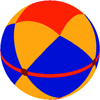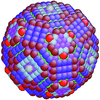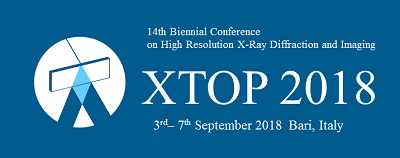issue contents
August 2018 issue

Cover illustration: Computed X-ray microtomography of a 3.48 Ga-old cherty rock from the Dresser Formation (Pilbara Craton, Australia), highlighting crystals shown to be aragonite pseudomorphs [Otálora et al. (2018). J. Appl. Cryst. 51, 1050-1058].
research papers
This article presents a theoretical study of X-ray diffuse scattering from local inhomogeneities of the In concentrations in epitaxial InGaN layers.
More accurate lattice parameters are obtained from electron tomography data by refinement from inter-spot distances in the two-dimensional diffraction patterns with corrections for sample displacement and geometric distortion.
For the first time, the α→γ′ martensitic transformation orientation relationship in Fe43.5Mn34Al15Ni7.5 (at.%) shape-memory alloy has been experimentally well established.
The structural transformations occurring during the intercalation of lithium into disordered graphite in a working battery are studied in detail by operando X-ray powder diffraction.
It is shown that the study of the singularities of an object's surface allows analytical predictions of the asymptotic behaviour of its amplitude form factor.
Open  access
access
 access
accessA real-time synchrotron radiation study of the crystalline phase, texture formation and resulting surface roughness during deposition of thin La and LaN films is presented. For LaN, the theoretically predicted metastable wurtzite and zincblende structures were found, while La assumes the expected NaCl structure.
Open  access
access
 access
accessThree-dimensional X-ray diffraction and X-ray computed tomography are used to study the grain-scale response of angular granular materials to understand grain kinematics, stresses and rotations during compaction and to compare the responses of angular grains with those of spherical grains.
In the current work, the experimental and quantum chemical approach has been applied to a 5-bromo-2-thienyl-4′-nitrochalcone derivative which possesses good nonlinear optical properties.
Growth striae and dislocations are observed in a ZnGeP2 single crystal at different stages of crystal growth using X-ray transmission topography. The full widths at half-maximum of rocking curves along the ZnGeP2 sample are determined by high-resolution X-ray diffractometry, and misorientations of low-angle boundaries are observed.
Open  access
access
 access
accessCrystallographic methods are used to identify the primary mineral phase of pseudomorphs of crystals embedded in 3.48 Ga bedded carbonate-chert rocks from the Dresser Formation, Pilbara Craton, Australia. This identification provides valuable information on the chemical environments at the onset of life on Earth.
The implementation and use of a set of new displacement parameter restraints is described. Anisotropic displacement parameters account for a large proportion of the parameters in a crystallographic refinement, but very few restraints for controlling their values have been implemented in standard crystallographic refinement programs.
Interfacial structural transformation and related iron reduction taking place upon epitaxial deposition of 3d metals on iron-based oxides are studied by electron and X-ray diffraction as well as by X-ray absorption spectroscopy.
This work presents the application of a novel high-resolution X-ray diffraction technique using medium-energy (≤21 keV) synchrotron X-rays and a fast one-dimensional Mythen detector developed for promoting studies of the deformation mechanism in Mg alloys under uniaxial mechanical loading at room temperature.
Download citation


Download citation


The fast data collection achievable using continuous rotation electron diffraction (cRED) has proven to be very effective in the structure solution and refinement of nano- and submicrometre-sized crystals. It is found that, despite the high R1 values, refined atomic positions obtained using cRED data collected from different crystals are consistent with those refined against single-crystal X-ray diffraction data. This shows that accurate structures can be obtained from cRED data.
A systematic rigorous self-consistent modeling study of diffraction experiments from nancrystalline powders and thin films was performed. The results show that for such samples the lattice parameters determined from single-peak or full-pattern analysis have size-dependent errors which are not due to artifacts of peak-fit and refinement routines.
The torque method uses rotational equilibrium conditions to predict the orientation of crystallization water in ionic crystals. The computed results can be used as constraints for crystal structure refinements and to provide complete crystallographic configurations for materials simulations.
A new method (orientation–trace method) to determine the parent β grain crystallographic orientation from one α lath in titanium alloys is described. This paper also elucidates the relation between the microstructure and texture of α lamellae in titanium alloys.
The Ni/GeSn solid-state reaction and the nature of the Ni-rich phase have been studied by combined X-ray diffraction analyses. It is demonstrated that the ∊-Ni5(Ge0.9Sn0.1)3 metastable phase with a hexagonal structure was obtained at low temperature.
The crystallographic parameters of several phases in unmodified and strontium-modified Al–6 wt% Si and A319 alloys were evaluated in solid and semisolid temperature ranges.
Prior knowledge must be included when determining the structure of macromolecules with small-angle scattering using analytical form factors. For that purpose, a Bayesian regularization method was implemented and compared with conventional unregularized analysis, resulting in solutions that were more consistent with the prior information and more stable upon addition of noise.
A method is presented for generating nearly uniform distributions of three-dimensional orientations in the presence of symmetry. The method is general and highly versatile as it can generate uniform distributions for any number of orientations and any symmetry, and even allows one to prescribe some orientations.
The moduli d11 and d14 of Ca3NbGa3Si2O14, La3Ga5.5Ta0.5O14 and La3Ga5SiO14 single crystals were measured with a triple-axis X-ray diffractometer under an external electric field which causes changes in the interplanar distances due to the reverse piezoelectric effect. The results of the X-ray diffractometry measurements agree fairly well with the results obtained by different methods.
Local-probe synchrotron X-ray diffraction has been used to study crystal orientation across full sections of biomineral fish otoliths and to reveal the internal histological domains. The use of two-dimensional detectors and data treatment reveals information from incomplete diffraction rings.
Open  access
access
 access
accessA sample environment cell for long-duration X-ray diffraction studies of mineral precipitation in very slow cooling aqueous environments on Earth and other planetary bodies is described. The results are reported of a year-long commissioning experiment monitoring the dynamics of a freezing MgSO4–H2O solution at −28°C (245 K) in which meridianiite and epsomite are observed to form.
The stacking disorder in ice I samples is analysed in a quantitative fashion using pair distribution functions derived from neutron total scattering. This approach is found to have several advantages compared with the traditional analysis of powder diffraction data.
teaching and education
Free 

short communications
In an earlier article, it was reported that angle calculations for the operation of an X-ray or neutron diffractometer must include at least one sample orienting angle. Here a mode using two detector circles and wavelength for angle calculations is introduced. This mode is useful when the sample rotation is limited or not allowed.
computer programs
The Open Chemistry Database (OChemDb) is a new free web portal which has been developed to assist in the crystal structure determination process by surveying on bond distances, bond angles, torsion angles, atom types and space groups. It uses a suitably designed database of solved crystal structures.
decryst is an open-source software suite for structure determination from powder diffraction using the direct-space method, which can apply anti-bump constraints automatically in global optimization using the efficient algorithm by Liu [Acta Cryst. (2017), A73, 414–422]. decryst can offer high performance because of the application of incremental computation, and is designed with parallel and distributed computing in mind.
GSASIIscriptable is a new module that provides extensible Python scripting and command-line access to some of the capabilities in GSAS-II, optionally using parallel computing.
A methodology to find the best plane for a set of atoms involved in metal coordination and the deviation of the remaining atoms from the plane is presented.
laboratory notes
A design for an air-cooled tube (`crystallization incubator') installed in a laboratory tube furnace is presented. The setup allows simultaneous regulation of different crystallization parameters in crucibles and Tamman test tubes, with the purpose of obtaining crystals.
book reviews
Free 



 journal menu
journal menu























































